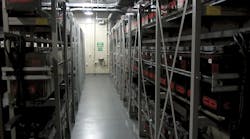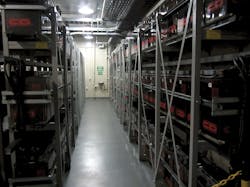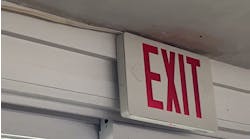Article 480 provides the electrical installation requirements for all stationary installations of electrical storage batteries (Photo). If you have batteries for photovoltaic (PV) systems, the additional requirements of Art. 690, Part VIII apply. But covering a battery system from square one to end of life requires far more knowledge than what is in Art. 480 (see SIDEBAR: Beyond Article 480).
Subsection changes
New with the 2014 NEC is a subsection on battery and cell terminations [480.3]. This replaces the former 480.3, which was titled “Wiring and Equipment Supplied from Batteries” and consisted of a single sentence.
What it said was, “Wiring and equipment supplied from storage batteries shall be subject to the applicable provisions of this Code applying to wiring and equipment operating at the same voltage, unless otherwise permitted by 480.4.”
If you read what this sentence says, you realize it could be omitted with no difference in how the Code is applied. That’s partly because there’s no reason to restate the fact that the Code applies to this wiring [90.3] and partly because subsection 480.4 does not need another subsection to make it legitimate.
Oddly enough, the 2014 revision moves what was in 480.3 to 480.4, and moves what was in 480.4 to 480.5. This would have created a cascading effect, whereby each subsection number was incremented by one. But that didn’t happen, because the content of what was in 480.5 in the 2011 revision was combined with the content of 480.6 in the 2014 revision. Strange as this juggling might seem, there was a good reason for it, as we will see.
The sheer amount of new text in subsection 480.3 shows us that whatever this is saying must have been important to the people serving on Code-Making Panel No. 13. The need to make this relatively extensive addition (and two others) in the limited time available is justification for merely moving the other subsections (as noted above) for now. As we cover these changes, you’ll see why getting them into this revision had to be a priority.
Terminations
Battery terminal corrosion has long been an issue raised at battery conferences. It turns out that a common cause of this is easily preventable. When the post is made of one metal and the connector of another, the basic rules of chemistry dictate that dissimilar metals will give you corrosion. But applying an antioxidant material suitable for the battery connection greatly alleviates this problem.
That’s why, for example, you can walk into any decent auto parts store and find they sell “battery installation” kits right along with batteries. The kit includes an antioxidant grease that you apply directly to the battery terminals.
When the terminal connection of your car battery corrodes, the usual outcome is an undercharging battery that fails prematurely. But when you have a density of battery jars, especially of the size you find in data center battery strings, the corrosion can easily morph from a performance issue into a safety issue.
This simple step transforms the safety issue into a maintenance issue. If the antioxidant is applied during installation, you’re dealing with maintaining the antioxidant periodically rather than dealing with corrosion continually (or with excess gassing that results in an explosion). Thus, the NEC now requires performing this step during the installation [480.3(A)].
A tenet of the good workmanship required by 110.12 is that you terminate conductors in a way that doesn’t put strain on the connection. Somehow, this hasn’t translated very well over to the installation of battery systems in many facilities. So the NEC now makes it an explicit requirement [480.3(C)] and takes it a step further to require the use of terminal plates where practicable.
Temperature
Temperature is also a huge issue with batteries. The discussion often focuses on how temperature affects the charging rate, while overlooking the effects on conductor ampacity. The NEC now addresses these effects.
When you run conductors between cells and between tiers, you must size them large enough to accommodate the loss of ampacity expected under maximum temperature conditions [480.3(B)]. It’s always been something a good battery systems designer has done. But not every installer is a good battery systems designer, so the NEC now explicitly requires this ampacity adjustment.
Prime movers
You don’t have to provide overcurrent protection for conductors from a battery at 50V (nominal) or less if it provides power for starting or controlling prime movers. And Sec. 300.3 doesn’t apply to these conductors. The text has not changed from the 2011 NEC, but the requirement is now in 480.5 instead of 480.4.
Disconnects
If the nominal voltage of the battery system is more than 50V, you must provide a disconnecting means for all ungrounded conductors derived from it [480.6(A)]. As is typically required in the NEC for a disconnecting means, this one must be in sight of what it disconnects (the battery system) — and it must be readily accessible. You can incorporate the disconnect into the DC busway if you’re using such a busway [480.6(C)].
What if you have controls to activate the disconnect remotely, and they aren’t within sight of the battery system? In that case:
• The disconnect must be capable of being locked in the open position.
• On the disconnect, you must field-mark the location of the remote controls.
The best time to mark the disconnect with this information is when you’re fulfilling the other disconnect field-marking requirements:
• Nominal battery voltage.
• Maximum available short circuit current derived from the stationary battery system, along with the date this was calculated.
Insulation
You don’t need to provide additional insulation support to Vented Lead Acid or Vented Alkaline Type batteries if their [480.7]:
• Nominal voltage is 250V or less.
• Covers are sealed to containers of nonconductive, heat-resistant material.
For Vented Alkaline Type batteries, cells in containers of conductive material must be installed in trays of conductive material with no more than 20 cells (24V, nominal) in series in any one tray.
You don’t need to provide additional insulation support to cells in rubber or composition containers where all cells in series don’t exceed a total of 150V nominal. If they do exceed 150V, sectionalize the batteries to get under that limit; then, install the individual cells for each group in trays or racks.
You don’t need to provide additional insulation support to sealed cells or multi-compartment sealed batteries of nonconductive, heat-resistant material. But you must provide it if the batteries are constructed of a conducting container and there’s a voltage between the container and ground.
Critical equipment
The remaining three subsections of Art. 480 address:
• Racks and trays [480.8].
• Battery locations [480.9].
• Vents [480.10].
There’s nothing in these subsections a good battery system designer wouldn’t do anyhow, and there’s plenty they don’t say. For example, they don’t address important issues with rack design. There’s no NEC requirement preventing you from installing a 5-tier rack with 4 in. between tiers. But try maintaining the cells and interconnections in such a design. The heat issues with it are also formidable, and good luck determining the correct float voltage. One thing you don’t do is try to get something “free” in terms of square footage, yet the effort to do so is a cause of poorly performing battery installations.
Poor engineering decisions made to satisfy poor management decisions made by higher-ups who don’t know an interconnect from a grounding strap will ensure an unreliable system. Making it NEC-compliant simply is not enough. So how can you get more resources allocated for a good design?
In most applications, batteries are critical equipment. Why does every large data center have battery installations that exceed NEC requirements? Because no executive wants to be the one who forced mediocre engineering decisions that resulted in a $2 million shutdown.
You’re installing a revenue loss prevention system. How much revenue per minute is at stake? Yes, satisfy Art. 480. But don’t stop there.
Lamendola is an electrical consultant located in Merriam, Kan. He can be reached at [email protected].
SIDEBAR: Beyond Article 480
Like the rest of the NEC, Art. 480 is not a design guide. It’s not going to help you size, select, or site the batteries. It’s not going to help you decide between a 2-tier rack and a 3-tier rack, nor will it give you advice on determining the correct charging rate.
Battery maintenance is outside the scope of the NEC, but fail to do it properly and you have defeated the purpose of installing the batteries in the first place. The IEEE has several standards pertaining to battery maintenance, depending upon the type of battery involved.
The Informational Note under 480.1 lists seven standards that anyone with responsibility for a stationary battery system should take the time to become familiar with. If your job includes responsibility for keeping the battery system reliable, take advantage of the seminars and other training provided by manufacturers of batteries and battery test equipment.





